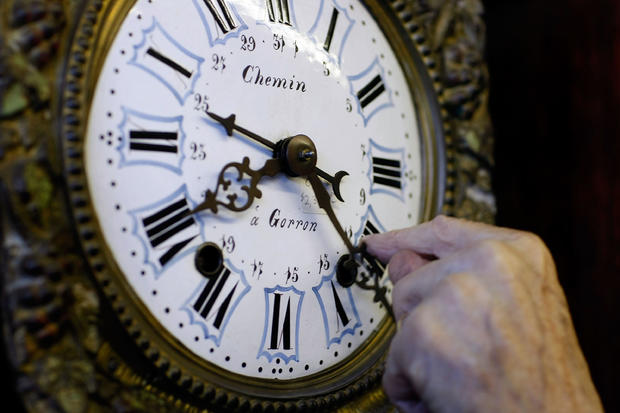When does the time change for daylight saving time 2023? What to know before clocks "fall back"
Daylight saving time for 2023 will end on Nov. 5 with most Americans having to "fall back" for the biannual time change and turn their clocks back an hour — and it looks likely to remain that way for the foreseeable future.
Two Florida Republicans introduced the Sunshine Protection Act of 2023 in March to make daylight saving time permanent after the proposal faltered in the last Congress, but so far the bill hasn't made any significant inroads, all but guaranteeing that most Americans will have another year of changing their clocks.

Before this latest attempt to alter the biannual ritual started on Capitol Hill, "falling back" and "springing forward" caused considerable consternation amongst Americans. Parents who want their children to head to school in the daylight can appreciate "falling back" to standard time, but those who want the sun to shine long enough to play in the park after classes may want to keep daylight saving time year-round. Permanently keeping one over the other means people won't have their sleeping schedules disrupted twice a year.
In 2022, a CBS News/YouGov poll found 46% of Americans supported having daylight saving time year-round while 33% wanted to make standard time permanent. Just over a fifth of Americans, 21%, preferred keeping things the way they are.
Nineteen states have already passed legislation to stay on daylight saving time permanently if Congress would let them.
Before the clocks "fall back," here's what Americans need to know:
Will clocks "fall back" in 2023?
Yes. Americans in most states will have to turn their clocks back an hour on Sunday, Nov. 5, when standard time resumes. It will last until the second Sunday of March 2024, when daylight saving time starts again.
While daylight saving time shifts an hour of daylight from the morning to the evening in late winter, spring, summer and early fall, that hour of daylight goes back to the morning during standard time, when the days are shorter in fall and winter.
Sen. Marco Rubio, a Republican from Florida who introduced the Sunshine Protection Act in the Senate and a similar version of the bill last year, has emphasized that less daylight in the evening can mean fewer after-school activities for kids.
"One of the big problems we have in a lot of parts of this country is kids can't do anything after school because if you don't have a park with lights, then, you know, you're out of business by 4, 4:30, 5 o'clock," he said on "CBS Mornings" in March. "It's a huge problem, it's a huge issue in many parts of the country."
What states have gotten rid of daylight saving time?
Hawaii and most of Arizona don't observe daylight saving time. In the northeastern corner of Arizona, the Navajo Nation does observe daylight saving time, keeping the time the same year-round in the country's largest Native American reservation, which extends into New Mexico and Utah.
The U.S. territories of American Samoa, Guam and the Northern Mariana Islands in the Pacific also don't observe daylight saving time, along with Puerto Rico and the U.S. Virgin Islands in the Caribbean.
According to the U.S. Transportation Department, which oversees the observance of daylight saving time for the country, states can pass legislation to opt out of it. However, states don't have the authority to be on daylight saving time year-round.
Which ones are trying to get rid of daylight saving time?
Several other states have considered adopting standard time year-round, according to the National Conference of State Legislatures, which tracks legislation moving through state capitols across the country.
In five states this year — Arkansas, Connecticut, Montana, New Mexico and Wyoming — measures to eliminate daylight saving time have failed, according to the group.
Similar proposals are being considered in 10 states: Maine, Massachusetts, Minnesota, New York, Oregon, Pennsylvania, South Carolina, Tennessee, Texas and Vermont. In Oklahoma, lawmakers are weighing letting voters decide whether the state should adopt year-round standard time in a referendum.
In Idaho, a proposal was rejected to keep the southern part of the state, which is in the Mountain time zone, on standard time while residents in the northern part of the state, in the Pacific time zone, would continue changing their clocks twice a year.
Will daylight saving time go away permanently across the U.S. anytime soon?
It's not likely. Rubio's 2022 proposal would have delayed making daylight saving time permanent until this November to let airlines and other industries that make plans far in advance adjust to the change. Any new legislation without a similar delay would risk disrupting those businesses.
As for Rubio's current proposal to make daylight saving time permanent, the senator said in March he wasn't going to give up.
"This is Washington, someone always has a reason to be against something, you know?" Rubio said. "The answer is we'll see. I mean, it doesn't look right now like we have the votes to pass it, but we'll keep trying."
- In:
- Daylight Saving Time
Alex Sundby is a senior editor for CBSNews.com
TwitterDisclaimer: The copyright of this article belongs to the original author. Reposting this article is solely for the purpose of information dissemination and does not constitute any investment advice. If there is any infringement, please contact us immediately. We will make corrections or deletions as necessary. Thank you.







